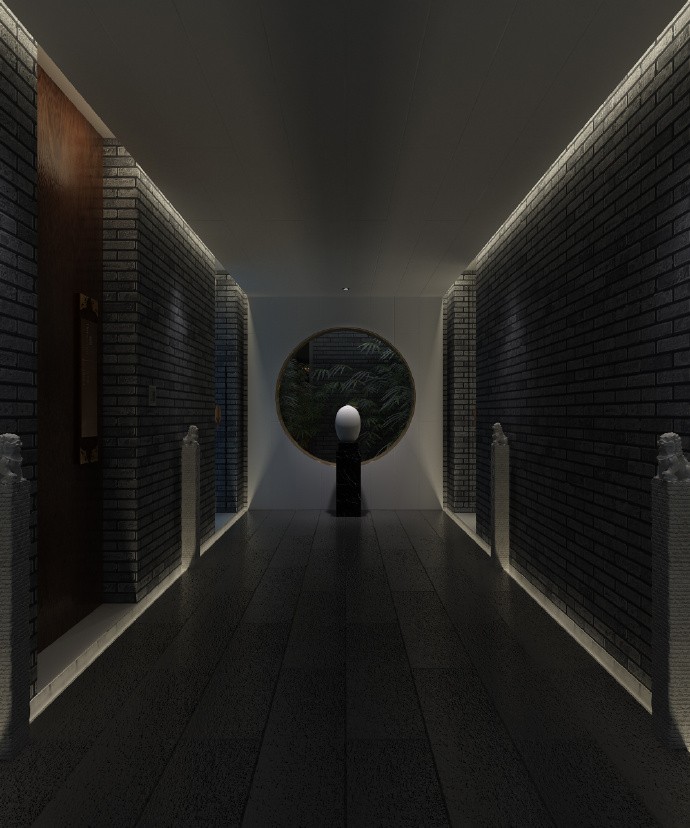House in the Woods Claim
2014-02-12 01:00
Text description provided by the architects. Small spaciousness
树林里的房子是一对夫妇和他们的客人的住所。尽管可供建造的面积非常有限,而且用户对床位和房间的数量要求很高,但还是出现了一个明显宽敞的住宅。
The house in the woods is a residence for a couple and their guests. Despite the very limited area available for construction and the users’ requirements regarding the number of beds and rooms, a residence with a perceptible spaciousness arose.
从“平房”的刻板印象出发,该设计具有开放性和隐蔽性,相对于设定的边界引入了平滑的过渡,强调了表面和体积的相关性,从而覆盖了熟悉的新事物。
Starting from the ‘bungalow’ stereotype, the design sets openness against seclusion, introduces smooth transitions in contrast to set boundaries, emphasizes the correlation of surface and volume and, in this way, overlays the familiar with the new.
One space rather than many
紧凑型建筑的基本结构由两个稍微旋转的长方体组成,每个长方体面积约60平方米。这种体积结构对应于程序划分为“生活区”和“睡眠区”。
The basic structure of the compact building volume consists of two slightly rotated cuboids, each with an area of about 60 square meters. This volumetric structure corresponds to the programmaticdivision into "living area" and "sleeping area".
尽管这一功能差异,开放式平面图及其中央弯曲创造了一个连续的,拉长的空间,向东-西延伸,结构由插入的木质空间和框架的一系列附属房间沿北部。
Despite this functional differentiation, the open floor plan with its central bend creates a continuous, elongated space, stretching in an east-west direction, structured by an inserted wooden volume and framed by a sequence of ancillary rooms along the north.
房子的公共和私人区域之间的距离是通过插入书房、客房和公用室来实现的。
A distance between the common and private areas of the house is achieved through the insertion of the study, guest and utility rooms.
屋顶的几何形状在平面图上是不对称的-山脊移动到“活立方体”的中轴,然后向北移动。它将两个长方体合并成一个独立的、独特的体积。整个内部由屋顶的倾斜表面所支配。通过这种统一的元素和由此产生的高度,空间显得慷慨和开放。
The geometry of the roof is placed asymmetrically over the plan - with the ridge moved to the middle axis of the ‘living cube’ and shifted to the north. It merges the two cuboids into oneindependent, distinct volume. The entire interior is dominated by the sloping surfaces of the roof. By means of this unifying element and the resulting height, the spaces appear generous and open.
除了南面的立面外,屋顶的体积还追踪着立面的走向。在南侧,外墙在一个钝角相交,屋顶的体积延伸到两个建筑的角落之间。由此产生的有盖的门廊突出了建筑的体积。在这里,设计的可塑性向内翻转,呈现出建筑的内在逻辑。
Except for the southern facade, the roof volume traces the course of the facade. On the south side, where the outer walls meet at an obtuse angle, the roof volume stretches between the two building corners. The resulting covered porch accentuates the building volume. Here, the plasticity of the design turns inside out and presents the inherent logic of the building.
Density and openness / transition
沿北立面,密集的一系列房间,包括入口,厨房,浴室和书房与画廊的水平,形成了功能骨干。沿着南面,开阔的平面图延伸到森林和花园。
Along the north facade, a dense sequence of rooms, including entrance, kitchen, bathrooms and the study room with a gallery level form the functional backbone. Along the south facade the open floor plan extends to the forest and the garden.
通过稍微倾斜的布置,空间界限以精确排列的窗口建立改变视角,将视野引导到周围;南立面的大窗户强调弯曲的纵轴,将林地花园的不同区域相对于内部设置,而北立面的小窗户则支持雕塑整体的存在。
Through the slightly angled arrangement, the spatial limits establish altering perspectives with precisely arranged windows, directing the views into the surrounding.The large windows of the south facade emphasize the bent longitudinal axis and set the different areas of the woodland garden in relation to the interior, while the small windows of the north facade support the sculptural presence of the total volume.
他们把周围森林生动的画面画在北面墙的内面上,东面和西面的方窗伴随着南面起居空间与北面相关区域的空间转换,支撑着表面纵轴以外的空间连续体:卧室和浴室,客厅和书房与画廊的水平是靠窗户绑在一起的。
They draw up vivid tableaus of the surrounding forest onto the inner surface of the northern wall.The squared windows of the east and west facade accompany the spatial transition between the south-facing living spaces and the related areas on the north façade, sustaining the spatial continuum beyond the apparent longitudinal axis: the bedroom and the bathroom, the living room and the study room with its gallery level are tied together by the windows.
The forest in place of the lawn
该遗址位于波茨坦附近的一片森林中。它是一个古老的树木种群的高耸松树,他们的红色闪烁的树皮作为主要的垂直元素,生长在柔软,沙丘。树顶屋顶使人联想到森林地面上不断变化的光影,这种光影景象投射在墙壁和屋顶的表面上,而周围森林和花园的叶子则在大窗户中被不同程度地反射出来。
The site is situated in a forest near Potsdam. It is distinguished by an old tree population of towering pines with their red shimmering bark as the dominant vertical elements, growing up from soft, sandy hills. The treetop roof conjures an ever-changing play of light and shadow on the forest ground.This spectacle of light and shadow is projected onto the surfaces of the walls and the roof, while the foliage of the surrounding forest and garden is diversely reflected in the large windows.
该设计与网站的特殊性进行了对话。它的水平范围突出了自然的、垂直的元素,并给它们广泛扩展的顶部留出了空间。
The design enters into a dialogue with the particularities of the site. Its horizontal extent accentuates the natural, vertical elements and gives room to their wide-spreading crowns.
门面保持在无光泽的黑色。它温和地融入了森林周围的绿色。室内的白色向内翻到南面,那里的室内空间向花园敞开。
The facade is kept in matte black. It merges modestly into the surrounding green of the forest. The white of the interior turns inside out on the southern facade, where the interior space opens towards the garden.
室内设计是谨慎的,构成了丰富多彩的生活的背景。它使用有限的材料和颜色。壁橱和架子都嵌在墙上,保持了房间的宽敞和整体几何的清晰。
The interior design is discreet and forms the background for the colorful things of life. It employs a limited range of materials and colors. Cupboards and shelves are embedded into the walls, maintaining the spaciousness of the rooms and the clarity of the overall geometry.
 举报
举报
别默默的看了,快登录帮我评论一下吧!:)
注册
登录
更多评论
相关文章
-

描边风设计中,最容易犯的8种问题分析
2018年走过了四分之一,LOGO设计趋势也清晰了LOGO设计
-

描边风设计中,最容易犯的8种问题分析
2018年走过了四分之一,LOGO设计趋势也清晰了LOGO设计
-

描边风设计中,最容易犯的8种问题分析
2018年走过了四分之一,LOGO设计趋势也清晰了LOGO设计
































































































